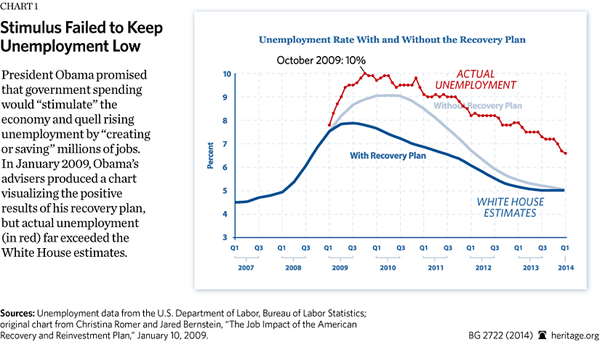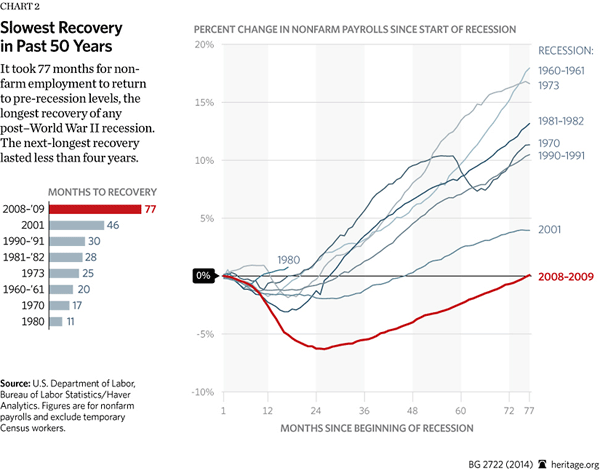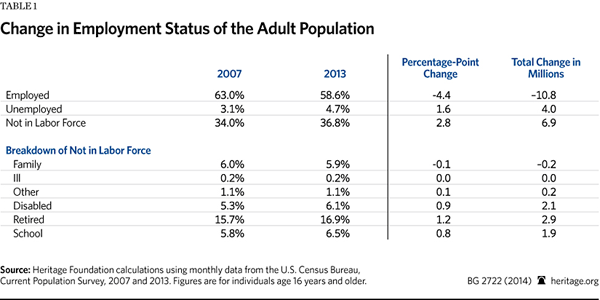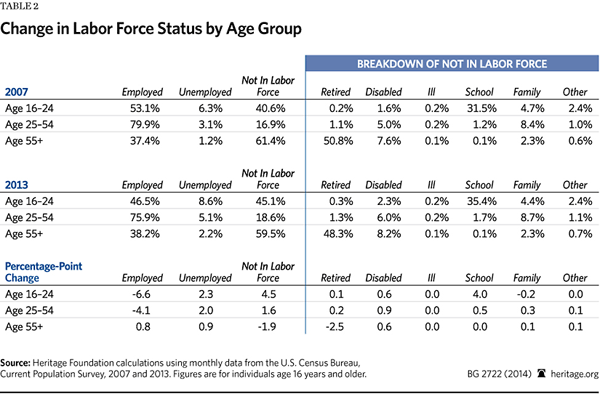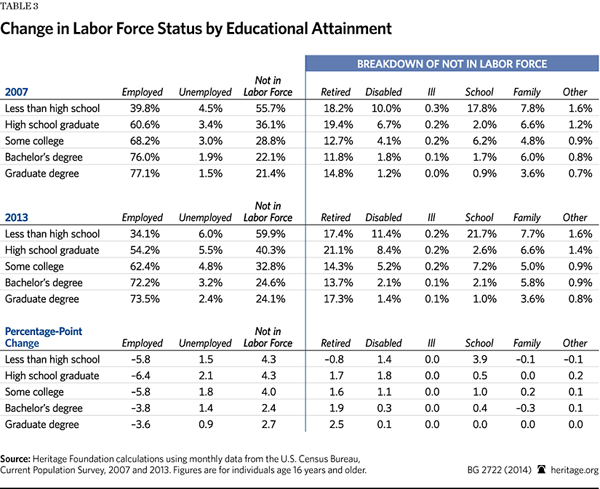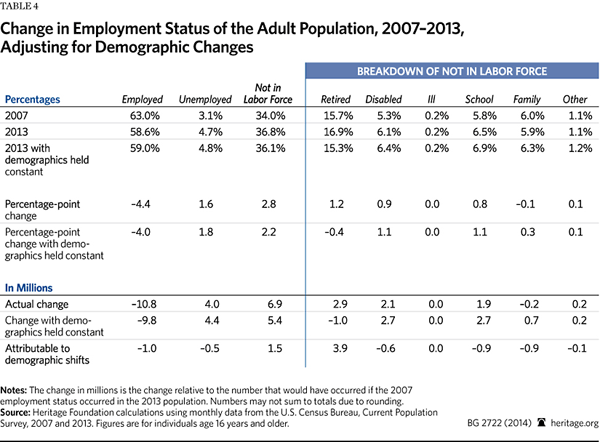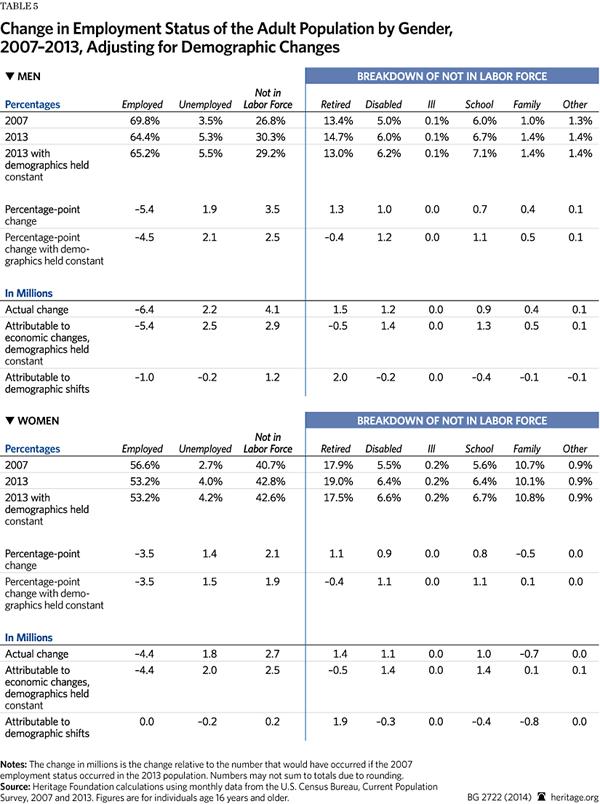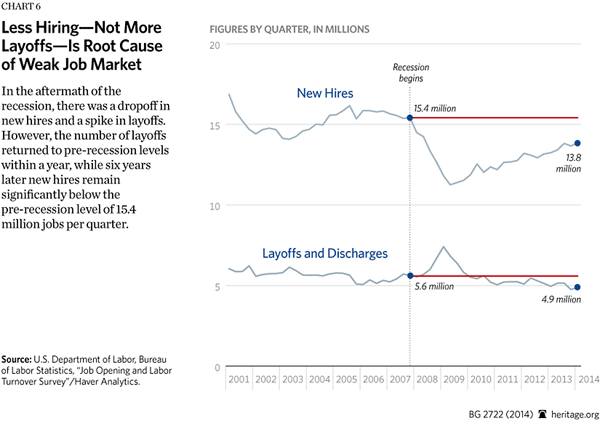Originally published August 30, 2012—Revised and updated September 4, 2014
The American economy is experiencing the slowest recovery in 70 years. In addition to persistently high unemployment, labor force participation has fallen sharply since the recession began in December 2007. Today, 6.9 million fewer Americans are working or looking for work. This drop accounts for virtually the entire reduction of the unemployment rate since 2009 because those not looking for work do not count as unemployed.
Demographic changes explain less than one-quarter of the drop in labor force participation. The Council of Economic Advisers (CEA) estimate that demographics explain half of the drop in labor force participation, but the estimate ignores the effect of rising education rates. The baby boomers are aging and thus more likely to retire, dropping out of the labor force, while the population has become more educated and thus more likely to work. These demographic changes together explain less than one-quarter of the drop in labor force participation.
The remaining drop in participation primarily comes from millions more people collecting Social Security Disability Insurance (SSDI) or attending school. While those enrolled in school will probably return to the labor force, those going on the disability rolls will not. They will remain permanently outside the labor force.
The difficulty of finding a job drives both these changes. Job creation fell sharply after the recession began and—unlike layoffs—has only partially recovered. The government’s responses have been ineffective at best and counterproductive at worst. The stimulus provided little if any boost to the economy and will depress the economy in future years. The Dodd–Frank Act has hurt capital markets and hurt businesses seeking to expand.[1] Federal Reserve Banks find many businesses reporting that Obamacare has made hiring more expensive.[2] Instead of public works programs and counterproductive regulations, Congress should reduce the tax and regulatory burdens that it imposes on businesses to encourage hiring and stop the fall in labor force participation.
The Slow Recovery
The collapse of the housing bubble and the resulting financial crisis sent the U.S. economy into a recession in December 2007. Recessions and financial crises are not unusual. The savings and loan crisis and the Volcker disinflation contributed to the recessions of the early 1990s and 1980s, respectively. The recoveries from both of these recessions were strong. Today’s economy is unusual in how slowly it is recovering.
Officially, the most recent recession ended in June 2009—the last month of the last quarter of the economic contraction that began in 2008. When President Barack Obama took office in early 2009, his Administration projected that unemployment would fall to 7 percent by the end of 2010 if Congress passed his stimulus package. The Administration warned that unemployment would hit 9 percent by the end of that year if Congress did not pass the stimulus package. Congress passed the stimulus, yet the unemployment rate hit 10 percent in October 2009 and did not fall below 9 percent until late 2011.
Not until May of 2014 did total employment reach its pre-recession peak—five years after the recession formally ended.[3] May’s unemployment rate stood at 6.3 percent—the lowest since the recession began—but also matched the highest unemployment rate following the 2001 recession.[4]
This has been the slowest recovery in the postwar era. After every other recession, the economy fully replaced the lost (net) employment within two to four years of the recession’s onset. Investors and entrepreneurs rapidly found productive new uses for the millions of idled workers and billions in idle capital. Not since the Great Depression has employment remained below its pre-recession levels more than six years after a downturn’s onset.
Lower Participation = Lower Unemployment Rate. As high as the unemployment numbers are, they still overstate the economy’s performance. Since the recession began, the labor force participation rate—the proportion of adults either working or trying to find work—has fallen by 3.2 percentage points. The government counts only people actively looking for jobs as unemployed. The drop in labor force participation accounts for almost the entire net drop in the unemployment rate over the past five years.
Another measure of the state of the labor market is the employment–population ratio. This ratio shows employees as a proportion of all adults, both those looking for work and those outside the labor force. During the recession, the employment–population ratio fell sharply and the unemployment rate increased. Since then, the unemployment rate has improved modestly. The employment–population ratio barely increased.
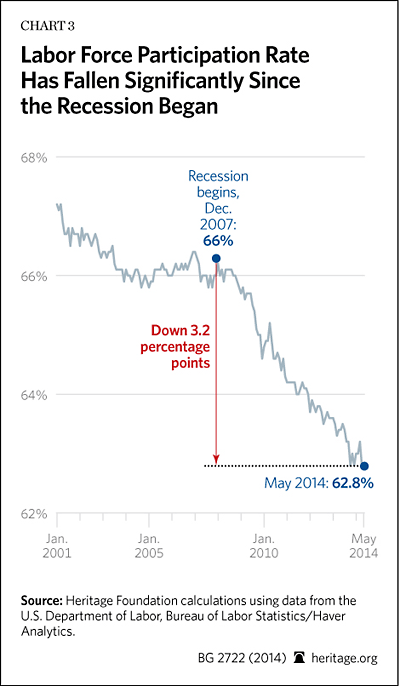
The unemployment rate peaked at 10.0 percent in October 2009 and currently stands at 6.3 percent. The employment–population ratio has gone from 58.5 percent to 58.9 percent during this time. Unemployment has fallen because fewer Americans are looking for work, not because more Americans are finding jobs. Since the recession ended, job creation has only slightly exceeded population growth.
A Smaller Labor Force—What It Means
Understanding why labor force participation has fallen is critically important to assessing the state of the economy. When millions of people would like to be employed, but have given up on finding work, the official unemployment rate understates the weakness of the labor market. It omits millions of potential workers who have become so discouraged that they have stopped job searching.
On the other hand, economists projected labor force participation to fall no matter what happened to the labor market. The first of the baby boomers turned 65 in 2011. People in their 60s work considerably less and have much higher retirement rates than those in their 50s. An aging population will push down labor force participation whether the economy does well or poorly. The aging of the baby boomers presents economic challenges for America, but these challenges have nothing to do with the cyclical state of the economy. If demographic changes explain most of the drop in labor force participation, then the unemployment rate accurately measures the health of the economy.
Examining the Drop in Employment. The Bureau of Labor Statistics (BLS) surveys a representative sample of tens of thousands of households each month. The BLS reports the proportion of Americans who are employed, unemployed, and not in the labor force. People outside the labor force do many things: enjoy their retirement, study in school, collect disability benefits, take care of family members, or fight illness.[5] The BLS asks individuals outside the labor force what they are doing, but does not regularly report these details.
The Heritage Foundation analyzed microdata from the BLS’s Current Population Survey to break down the changes in employment, unemployment, and those outside the labor force. Table 1 shows the changes in these figures between 2007 (the last year before the recession) and 2013 (the most recent full year in the recovery).[6] Table 1 also shows how those figures would be different if the employment, unemployment, and not-in-labor-force rates had remained constant between 2007 and 2013.[7]
Between 2007 and 2013 the employment–population ratio fell by 4.4 percentage points, while the unemployment–population ratio increased by 1.6 percentage points and the labor force participation rate fell by 2.8 percentage points.[8] If employment and unemployment had remained at their previous rates, 10.8 million more Americans would have jobs, meaning 4.0 million fewer unemployed Americans and 6.9 million more Americans participating in the labor force.[9]
Three categories explain the bulk of the decrease in labor force participation. The proportion of those outside the labor force and attending school has risen by 0.8 percentage points (1.9 million people), the proportion collecting Disability Insurance has risen by 0.9 percentage points (2.1 million people), and the proportion of retirees increased by 1.2 percentage points (2.9 million people). The proportion of those outside the labor force and spending time with family (–0.1 percentage points) or outside the labor force for “other” reasons (+0.1 percentage points) changed only slightly. The proportion of those not working due to illness remained constant.
These figures do not reveal what portion of these changes demographic changes caused and what portion the recession caused. The aging of the baby boomers should naturally cause more Americans to retire, pushing down labor force participation. Conversely, the generation of workers currently retiring has less education than the generations succeeding them. More educated workers have higher labor force participation rates. Rising education levels increase labor force participation.
Change in Labor Force Status by Age. Table 2 shows the change in the employment status of the adult population by age and education categories. The recession has not affected everyone equally. Workers ages 16 to 24 experienced the largest drop in employment (–6.6 percentage points) and the largest increase in those outside the labor force (+4.5 percentage points). Conversely, the employment rate of workers 55 and older increased noticeably (+0.8 percentage point), and the proportion of those 55 and older outside the labor force fell by 1.9 percentage points.
The latter change is driven by a sharp decrease in retirement rates (–2.5 percentage points). Older Americans are less likely to retire now than before the recession began. However, workers 55 and older are still more likely to be outside the labor force (usually retired) than any other age group. Consequently, the aging of the population has increased the number of retirees even as the retirement rates of older Americans have fallen.
The increase in Disability Insurance varies only slightly by age group. Workers in all age groups were between 0.6 and 0.9 percentage point more likely to receive Disability Insurance in 2013. The same is not true of schooling. The largest increase in those outside the labor force and attending school unsurprisingly came among younger workers (+4.0 percentage points).
This does not necessarily mean that younger Americans are enrolling in school at a higher rate than in 2007. The “employed” and “not in the labor force–in school” categories are mutually exclusive. These figures could also mean that students who in the past would have had part-time jobs now cannot find work. Thus, they are classified as outside the labor force instead of as employed. These figures show how the activities of those outside the labor force have changed. They do not show whether those outside the labor force and in school would take jobs if they could get them.
Change in Labor Force Status by Education. Table 3 shows how the labor force status has changed by educational attainment.[10] Even before the recession those with more education were more attached to the labor force and had lower unemployment rates. The burden of the recession has fallen heaviest on those with less education. The employment rates of those with less than a high school degree (–5.8 percentage points) and high school graduates (–6.4 percentage points) have fallen the most. These groups also have the largest decreases in labor force participation (–4.3 percentage points for each). Workers with bachelor’s degrees saw considerably smaller (–3.8 percentage points) decreases in their employment rates and labor force participation rates (–2.4 percentage points).
A substantial part of the drop in labor force participation for workers without a high school degree comes from those enrolled in school (+3.9 percentage points). A large number of these individuals are younger Americans studying in high school. The recession has encouraged many of them to continue their education because they will have difficulty finding work if they drop out. Similarly, difficulty finding part-time jobs has caused many students to stop looking for work and thus drop out of the labor force, although they remain in school.
Table 3 also shows notable differences in Disability Insurance claims. The increase in workers dropping out of the labor force and going on Disability Insurance was greatest for workers with at most a high school degree (+1.8 percentage points) or who have not finished high school (+1.4 percent). Workers with a bachelor’s degree or a graduate degree were considerably less likely to increase their use of Disability Insurance (+0.3 and +0.1 percentage points, respectively).
Holding Demographics Constant. Older workers are less likely to participate in the labor force than younger workers. More educated workers are more likely to participate in the labor force than less educated workers. America became older and more educated between 2007 and 2013. Such demographic factors have put both upward and downward pressure on the labor force participation rate. Tables 2 and 3 demonstrate the importance of controlling for these factors.
One way to control for demographic changes is to calculate what the employment status of the overall population would look like if the age, sex, and education distribution of the population did not change but the employment status of each separate age-sex-education group changed as it actually did.[11] This hypothetical employment status shows what the unemployment rate would have been if demographics remained unchanged since 2007.
Table 4 shows the actual and hypothetical change in the employment status of the adult population. The employment–population ratio fell by 4.4 percentage points, of which 4.0 percentage points remain after controlling for demographics. Similarly, 2.2 percentage points (5.4 million people) of the 2.8 percentage point (6.9 million people) decrease in labor force participation remains after controlling for demographic factors. Under one-quarter of the drop in labor force participation is due to demographic—not strictly economic—factors. The Federal Reserve Bank of Chicago has come to the same conclusion, finding that demographic factors accounted for one-quarter of the drop in labor force participation between 2008 and 2011.[12]
The Council of Economic Advisers recently concluded that demographic changes accounts for roughly half the drop in labor force participation.[13] They came to this conclusion by examining population aging in detail. While the CEA thoroughly examined population aging, they did not simultaneously control for education rates. The population has also become more educated since 2007, and more educated workers have greater attachment to the labor force. This factor should push labor force participation rates up.
Rerunning the analysis shown in Tables 3 and 4, but only accounting for aging would find demographics accounting for half the drop in labor force participation, as the CEA did. Accounting for aging and education simultaneously shows that demographics explains less than a quarter of the drop in labor force participation.
After accounting for demographics, three major categories of workers outside the labor force changed significantly between 2007 and 2013.[14] Increased retirements due to the aging population decreased the labor force participation rate by 1.2 percentage points.[15] Older workers have become much less likely to retire since 2007. If America’s demographic makeup had not changed between 2007 and 2013, lower retirement rates would have increased the labor force participation rate by 0.4 percentage points.
Controlling for demographics also changes the apparent magnitude of changes in those outside the labor force and attending school. The demographics-adjusted increase rises from 0.8 percentage point (1.9 million people) to 1.1 percentage points (2.7 million people). An aging population means fewer youth—those most likely to enroll in school. Controlling for this the increase in those not participating in the labor force and enrolled in school becomes even more pronounced.
A similar phenomenon explains the demographics-adjusted increase in Disability Insurance recipients. Overall the proportion of workers claiming Disability Insurance increased by 0.9 percentage point (2.1 million people). However, more educated workers are less likely to collect Disability Insurance than workers with lower levels of education. (See Table 3.) As older workers leave the labor force, their replacements have more education on average. This trend should reduce disability claims. If the population had not become more educated, even more people would have applied for disability than actually did. Statistical analysis shows disability claims would have risen by 1.1 percentage point (2.7 million workers). Controlling for demographic changes makes the recent increase in Disability Insurance even more pronounced.
Each of these factors—disability claims, schooling, and retirement—reflects weakness in the labor market.
Rising Disability Insurance Claims
Americans have not become sicker over the past 10 years. Surveys show that Americans’ health has improved. Mortality rates have also fallen. Advances in medical technology allow most Americans to live healthier and better lives.[16] Nonetheless, Disability Insurance claims continue to rise.
The Current Population Survey data showing rising disability claims tracks closely with Social Security Administration (SSA) data. SSA data show the number of workers applying for SSDI benefits has steadily increased, and that increase accelerated during the recession. By the end of 2001, the SSA was paying disability benefits to 5.3 million workers and was granting disability status to an average of 57,600 people per month.[17] By December 2007, those figures had grown to 7.1 million workers collecting SSDI and an average of 68,900 new disability benefits awards per month. During the recession, SSDI use increased even more rapidly. By the end of 2010, the SSA was adding approximately 90,000 workers per month to the SSDI rolls, which totaled 8.2 million workers.
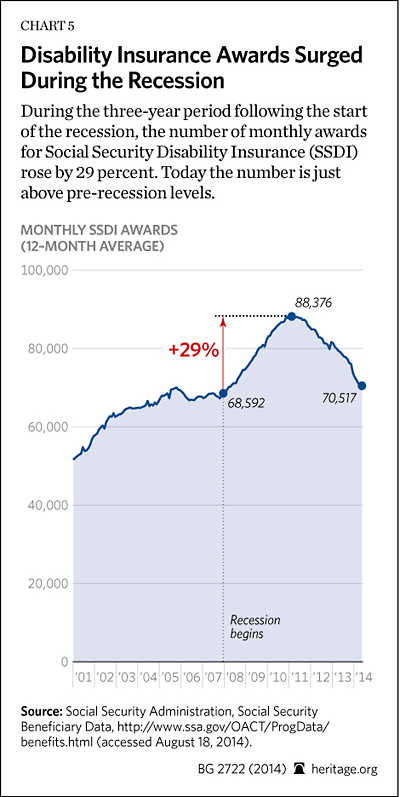
Since 2010, the pace of SSDI applications has returned to pre-recession levels. In the 12 months ending in May 2014, an average of 70,500 workers a month began collecting SSDI benefits. However, the SSDI rolls have not dropped. The new entrants have remained in the system. In May 2014, 8.9 million workers collected disability benefits.[18] Over the past decade, the number of workers collecting Disability Insurance has risen by 2.9 million—a 48 percent increase.[19]
Studies show that a significant number of workers who apply for disability benefits are not entirely disabled. They have medical conditions that qualify them for benefits, but could work at some type of job under other circumstances. Given the option of receiving benefits, however, they take them.[20]
The effect is particularly pronounced for lower-income workers, who are much more likely to be affected by a difficult job market. SSDI benefits represent a significantly larger proportion of their potential earnings. In a recession, layoffs increase, especially among less skilled workers, and finding work becomes particularly difficult. This leads many workers who lose their jobs to apply for disability benefits instead.
Regrettably, few of these workers will ever return to the labor force. The overwhelming majority of people who leave the Disability Insurance program do so because they qualify for Social Security retirement benefits (55 percent) or because they die (35 percent). Just 9 percent leave the system because their health has improved enough that they no longer qualify for benefits.[21] Even fewer workers voluntarily leave Disability Insurance to work. Congress created the Ticket to Work program in 1999, which allowed SSDI beneficiaries to return to work while keeping their health coverage. Over the next seven years, fewer than 1,400 claimants used the program to return to work.[22]
The decrease in labor force participation as workers apply for disability benefits is probably permanent. In addition to hurting the economy by removing potential workers from the labor force, this decrease adds to the severe strain on the government’s finances. The government currently spends $143 billion a year on Disability Insurance payments and pays tens of billions more for health benefits for SSDI beneficiaries.[23] The Social Security Disability Insurance trust fund is rapidly exhausting its funds and will run out of money in 2016.[24]
School Enrollment. The proportion of workers outside the labor force and enrolled in school has also risen sharply in the recession. Together, the increased enrollment in school and the increase in workers collecting disability benefits account for virtually all of the non-demographic decrease in labor force participation. Like Disability Insurance, this reflects the weakness of the labor market, especially for younger workers.
The recession hit younger people particularly hard. Hiring fell sharply, reducing job openings. Young people face competition from more experienced workers for existing vacancies. As Table 2 shows, employment has fallen substantially more among 16-to-24-year-olds than among older workers.
The weak economy mechanically increases the proportion of workers classified as outside the labor force and enrolled in school. Many students who would have formerly taken part-time jobs cannot find work and have stopped looking. Thus, they go from being classified as employed to being outside the labor force.
The weak economy also encourages potential students to attend, return to, or remain in school. Education can help workers find jobs in a difficult economy. Further, one of the greatest costs of obtaining an education is the opportunity cost of going to school. Most students choose not to work full-time jobs while studying full time. They forgo the income they could have earned in order to study. In a recession, when job opportunities decrease, this opportunity cost falls. It becomes relatively less expensive to go to school: Students lose money by not working only if they could have found a job in the first place. A weak economy will cause many people to attend school that would not otherwise do so.
The Current Population Survey only asks those between the ages of 16 and 24 directly about their school enrollment.[25] As a result, it is possible to determine only the portion of this increase that comes from higher school enrollment for youth.
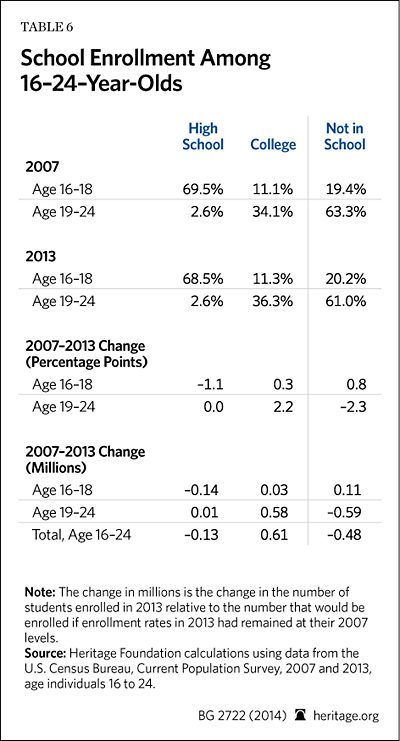
Table 6 shows how school enrollment has changed for 16-to-18-year-olds and for 19-to-24-year-olds since the recession began. College enrollment has increased modestly while high school enrollment fell slightly. Overall, 130,000 fewer young people are enrolled in high school and 610,000 more young people are enrolled in two-year and four-year colleges than if enrollment rates had not changed—a net increase of 480,000 students. The number of youth in school and not participating in the labor force has increased by 1.5 million.[26] Thus, among younger workers, about one-third of the net school-related decrease in labor force participation stems from increased school enrollment. The remaining two-thirds comes from the many youth not finding part-time jobs while in school.
Unlike workers who collect Disability Insurance, students are very likely to return to the labor force when they complete their studies. When they do, they will probably have greater earning potential. The recession has increased the number of people who do not participate in the labor force and who are in school. As long as these students are gaining valuable skills from their studies, this is unlikely to affect the economy negatively in the long term. If these workers do not gain useful skills, however, then they are accumulating a debt burden that will permanently hinder their finances.
Retirement. Decreasing retirement rates reflect a combination of the long-term shift to 401(k)-style defined-contribution (DC) retirement plans and the weaker economy. Defined-benefit (DB) pension plans provide workers with a fixed pension upon retirement. Once an employee with a DB pension qualifies for his maximum benefit, he has no financial incentive to keep working. His retirement income will not increase. Workers with a 401(k) plan, however, have strong incentives to keep working past their official retirement age. Each extra year of work adds to their savings and enables them to accumulate a larger nest egg. At the same time, delayed retirement allows workers to delay drawing down their savings. The increased use of DC pensions encourages employees to delay retirement.
Long-term retirement rates will probably continue to fall, even as demographic changes increase the number of retirees. The Congressional Budget Office predicts that the number of workers per Social Security beneficiary will fall from the current 3-to-1 ratio to 2-to-1 over the next 25 years.[27] Those not participating in the labor force can only consume the wealth produced by those working in it. An aging population means that older workers will either need to accept a lower standard of living in retirement—because there are fewer workers to support their consumption—or delay their retirement in order to accumulate larger savings.
Stalled Job Creation
What has caused the labor market weakness that has both kept unemployment high and depressed labor force participation? The immediate answer seems obvious: job losses. Thousands of companies have gone out of business or downsized, laying off millions of workers and increasing unemployment. While this answer contains a large element of truth, layoffs and job losses are not the main reason that unemployment remains high.
Layoffs surged at the start of the recession, rising from 5.6 million in the fourth quarter of 2007 to 7.4 million in the first quarter of 2009—a 32 percent increase.[28] Between 2007 and 2009, 16 percent of American workers went through at least one layoff.[29]
Since then, layoffs have returned to normal levels. In the first quarter of 2014, employers laid off 4.9 million workers.[30] Employees with jobs today are, in fact, slightly less likely to lose them than they were when the recession began.
Unemployment remains high because new job creation dropped when the recession began and has not recovered. Employers hired 13.8 million new employees in the first quarter of 2014—10 percent fewer than the 15.4 million new workers hired in the last quarter of 2007. Unemployment remains high primarily because businesses are creating fewer new jobs, not because of increased layoffs.
A Note to Congress
Job creation and new hiring remain low for several reasons. The most prominent are the lingering effects of the collapse of the housing bubble and resulting financial crisis, as well as the domestic consequences of the economic slowdowns in Europe and China.
The U.S. government has also contributed to the problem. New financial market regulations have held back investment and the economy. Excessive taxes and increased regulation discourage risk-taking and job creation. The fiscal cliff tax hike in January raised the average top marginal tax rate—including federal and state income taxes and payroll taxes—to 48 percent. In high-tax states, such as California and New York, the top tax rate exceeds 50 percent.[31] Entrepreneurs and business owners who take risks to expand their enterprises are allowed to keep barely half of their additional earnings, while bearing all of the downsides if their ventures fail. The Administration has also increased the regulatory burden facing businesses, especially in health care.
Small-business owners report that tax burden and government red tape are significant problems. In fact, small-business owners are more likely to cite either taxes (25 percent) or regulations and red tape (20 percent) than poor sales (12 percent) as their single greatest problem.[32]
Congress cannot control Europe’s economy or retroactively undo the housing bubble. However, Congress directly controls the taxes and regulations on employers. To increase labor force participation, Congress should:
- Reform the tax code to reduce the tax burden of almost 50 percent on job creators and the marginal tax rates of at least one-third on most workers;[33]
- Streamline or eliminate unnecessary regulations;
- Repeal the employer health care mandate, which discourages companies from creating full-time jobs;
- Reduce or repeal the regulatory burden on capital markets imposed by the Sarbanes–Oxley Act and the Dodd–Frank Act; and
- Add work requirements for all able-bodied adults receiving means-tested federal benefits so they do not discourage labor force participation.
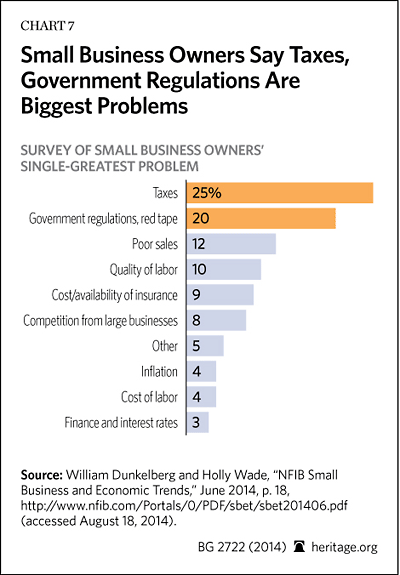
Conclusion
The economy has only gradually recovered from the Great Recession. More than six years after the recession started, unemployment remains high. Yet the unemployment rate does not fully measure the weakness in the economy. Labor force participation has fallen by more than 3 percentage points since the recession began. Some of that decrease is due to demographic factors, primarily the beginning retirements of baby boomers. However, such demographics explain less than one-quarter of the decrease. A weak labor market explains the remaining three-fourths of the drop in labor force participation.
The workers who have dropped out of the labor force for economic reasons are primarily engaged in collecting disability benefits or studying in school. Many workers have turned to disability benefits for income in the recession. This has increased the number of disability beneficiaries by 2.1 million since the recession began. These workers will probably remain permanently outside the labor force. Many other potential workers are outside the labor force, but attending school, partly reflecting the difficulty of finding work. Many students who would like part-time jobs cannot find them. Others have decided to enroll in or remain in school during the down economy.
The labor market remains weak not because of layoffs—which have sunk to pre-recession levels—but because job creation and new hiring have fallen. Congress can do nothing about the lingering effects of the housing bubble and European economic woes that continue to hold back the economy, but Congress can reduce the tax and regulatory burden it imposes on businesses. Small-business owners report that taxes and regulations are a greater problem than poor sales. Congress should reform the tax code and streamline unnecessary and overly burdensome regulations. The weakest labor market in two generations is no time to make it more difficult for businesses to expand and create jobs.
—James Sherk is Senior Policy Analyst in Labor Economics in the Center for Data Analysis at The Heritage Foundation. The author is grateful to Heritage Foundation intern Spencer Galbraith for his assistance with this report.
Appendix
Methodology
The principal data source for this report was the 2007 and 2013 monthly microdata from the Current Population Survey conducted by the Bureau of Labor Statistics in conjunction with the Census Bureau. Variable construction was a large part of the analysis.
Employment status was measured using a constructed variable combining two survey responses. One variable (PEMLR) classified respondents as “employed–at work,” “employed–absent,” “unemployed–on layoff,” “unemployed–looking,” “not in labor force–retired,” “not in labor force–disabled,” and “not in labor force–other.” The two employed and unemployed responses were combined to create single “employed” and “unemployed categories.” Another variable (PENLFACT) asks people outside the labor force what they are doing: disabled, ill, in school, taking care of home or family, in retirement, or other. The responses to these “not in the labor force” questions were combined with the responses to PEMLR to create one variable that classified workers under eight different possible employment statuses: (1) employed; (2) unemployed; (3) not in the labor force–retired; (4) not in the labor force–disabled; (5) not in the labor force–ill; (6) not in the labor force–taking care of family; (7) not in the labor force–at school; and (8) not in the labor force–other. The analysis presented in Tables 1 to 5 uses this constructed variable.
To control for demographic changes, Heritage Foundation analysts divided the population by male and female, by three age categories (16–24, 25–54, and 55+), and by five educational attainment categories (less than a high school degree, high school degree, some college, bachelor’s degree, or graduate degree). Workers with an associate’s degree were classified as having “some college” education. These three groupings produced 2 x 3 x 5 = 30 possible combinations (cells) of sex, age, education.
To control for demographics and produce Tables 4 and 5, Heritage Foundation analysts calculated the employment status of the adult population in 2007 and 2013 in each of these cells, as well as the proportion of the overall population they represented (i.e., women ages 25–54 with some college education made up 7.9 percent of the adult population in 2007 and 7.6 percent in 2013). Heritage analysts then constructed a hypothetical 2013 employment status by taking the average of the cell-specific employment statuses in 2013, weighted by the proportion of the overall population in each cell in 2007 instead of by the proportion in each cell in 2013 (i.e., 7.9 percent instead of 7.6 percent). This yields a hypothetical employment status for the economy assuming the sex, age, and education makeup of the U.S. had not changed in the recession.
Except in the SSA administrative data in Chart 5, the changes in the number of people reported for a given employment status are relative to the number of people that would have been in that status in 2013 if the labor participation rates had not changed. For example, Table 1 shows an increase of 2.1 million persons receiving Disability Insurance who are not in the labor force. Current Population Survey data show that 12.2 million people were on Disability Insurance in 2007 and 15.0 million people were on Disability Insurance in 2013—a 2.9 million person increase. However, the adult population also grew from 231.9 million to 245.7 million people. This would have increased the number of SSDI recipients even if the rate of SSDI receipt had not changed. The 2.1 million figure accounts for this population growth. It shows how many more people are on SSDI now than would have been the case if SSDI rates had remained at their 2007 level.
